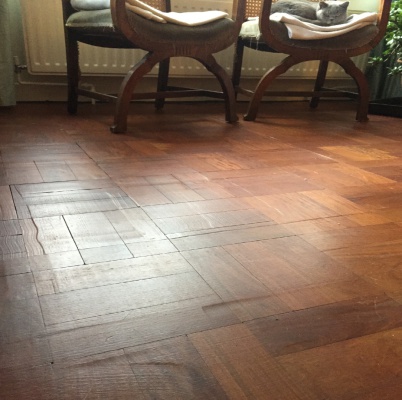Parquet flooring - restoration process
you should not attempt to sand/restore and refinish your parquet flooring yourself however below you will find the general sanding processes required.
It all sounds very straight foward - "we found some parquet flooring under our carpet" so you watch a youtube video hire a sander set up in your living room, sand papers on and you simply walk up and down it really is that easy.......wrong!!
Floor sanding is tough work, especially to those who have never attempted something similar before, give it your best. Unfortunately we have seen many projects which were left abandoned at some point and only made our work harder and more costly later on.
Parquet sanding is not just about having the best equipment to hand but knowing the process required.
One of the first steps of sanding a parquet is understanding what you are trying to achieve, in almost all cases this will be removing old warn finishes, unevenness and filling gaps allowing a new floor finish to be applied (see our floor finishes page).
Identifying wood grain direction - According to Wikipedia, this the longitudinal arrangement of wood fibres (direction the tree grows). One of the first steps anyone entering the field of floor restoration learns is to follow the grain of the wood when sanding. Now when your sanding floorboards this no problem planks are all installed parallel to one another unfortunately parquet blocks are laid in rows opposite to eachother.
So how do you sand with a conflict of grains with one going against the other? There are two main opinions out there on how to best approach this task, sanding straight up and down or diagonally (following the 45 degree angle).Both ways of sanding the parquet will get the job done unfortunately without a floor finishing machine like a Lagler Trio of Bona flexi sand you will be left with cross gain marks (cross grain marks are left by belt sanders if you pass over any timber floors not following the correct grain direction).
Respect the power of the sanders
A floor belt sander is very powerful machine you must not forget that it strips the wood blocks constantly as long as it is working and stopping in place for even a second can leave what we call a drum mark (a big dip) in your floor.
Grading of sand paper
Selecting the corect sand papers for your machines is a skill in its self, most parquet flooring retorations will be started on a p60 maybe even p40 in some rare circumstances followed by P60, p80 upto p100 some profressionals feel p120 is required but we would say this would only be for an oiled finish as they penetrate deep, a p100 leaves a good key to receive a lacquerd finish as your can imagine going to high with your sand papers will affectively start to polish the surface of the timber leading to seals not bonding correctly.
Gap filling
Although filling gaps in your parquet is not essential it will offer the best finish. Mixing dust collected during the sanding process mixed with Lecol 7500 resin works very well.
The finishing touch
The Bona flexi sand is the ultimate parquet floor finishing tool, Bona's unique 4-head power drive plate which can be used with Bona's Zirconium, Ceramic or Diamond 150mm discs to give your parquet floor a fine finish like no other.
Find us on:
TeL: 01722 421501
Wood flooring showroom open:
Appointment
only
Mon to Fri 8am - 5pm
Our address:







